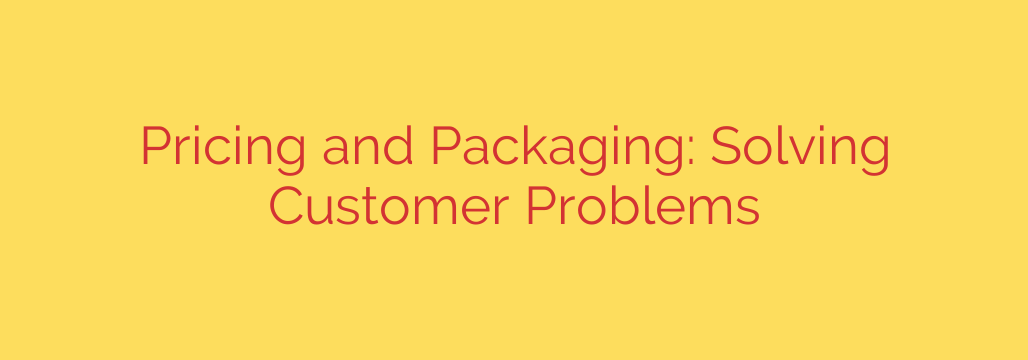
Unlock Growth with Value-Based Pricing: A Guide to Packaging Solutions Customers Crave
Is your pricing strategy holding you back? For many businesses, setting prices feels like a shot in the dark—a mix of competitor analysis, cost calculations, and guesswork. This often leads to packages that confuse customers and leave money on the table. The problem is a fundamental one: most companies price their features, not the solutions they provide.
To build a pricing model that fuels sustainable growth, you must shift your perspective. Stop asking, “How much does this feature cost to build?” and start asking, “How much value does this solution create for my customer?” This is the core of value-based pricing, a powerful strategy for aligning your product with the real-world problems your customers need to solve.
The Flaw in Traditional Pricing Models
Many companies fall into common pricing traps. Cost-plus pricing (your cost + a margin) ignores the customer’s perceived value entirely. Competitor-based pricing forces you into a race to the bottom, commoditizing your unique offerings.
The biggest mistake, however, is feature-based pricing. When you list dozens of features and assign arbitrary value to them, you force customers to become experts in your product just to make a decision. They don’t want to compare checklists; they want to know which package will fix their specific pain point.
Start with the Problem, Not the Product
The foundation of a successful pricing strategy is a deep understanding of your customer. Before you can package a solution, you must intimately understand the problem you are solving. This goes beyond surface-level demographics. You need to uncover their “job to be done”—the critical task or outcome they are trying to achieve.
Ask critical questions through customer interviews and surveys:
- What challenges are holding your business back?
- How do you currently measure success?
- What would a “perfect” solution enable you to do?
- What is the financial or operational cost of not solving this problem?
The answers to these questions are marketing gold. They allow you to move from selling software to selling outcomes, such as increased revenue, saved time, or reduced risk. Your pricing should reflect the value of the problem you solve, not the cost of the features you provide.
From Problems to Packages: The Art of Segmentation
Once you understand the core problems, you’ll likely notice that not all customers are the same. A freelancer has vastly different needs and budget constraints than a multinational corporation. This is where segmentation becomes critical.
Instead of creating generic “Good, Better, Best” tiers, segment your audience based on the distinct problems they face. Common segmentation models include:
- By Customer Size/Maturity: Solopreneur, Small Team, Growing Business, Enterprise.
- By Use Case: A marketing team uses your product differently than a sales or operations team.
- By Desired Outcome: One segment might want to automate basic tasks, while another wants deep strategic insights.
Effective packaging begins with smart customer segmentation. Each package should be a tailored solution for a specific customer profile, making their decision simple and intuitive.
Designing Your Value-Based Tiers: A Practical Framework
With your segments defined, you can now build packages that resonate. The key is to anchor them to a clear “value metric.”
A value metric is the unit by which your customer experiences value from your product—and it’s what you charge for. It could be per user, per project, per 1,000 contacts, or per gigabyte of data stored. A good value metric has two key characteristics:
- It’s easy for the customer to understand.
- It scales as the customer receives more value from your product.
With your value metric and segments in hand, you can design your tiers. For each tier, focus on the primary problem that segment faces. For example:
- Basic Tier (for Freelancers): Problem: Lacks organization and professional tools. Solution: Provides core features for managing individual projects and clients efficiently.
- Pro Tier (for Small Teams): Problem: Needs collaboration and better workflow. Solution: Adds team-based features, shared inboxes, and basic reporting.
- Business Tier (for Growing Companies): Problem: Requires automation, integration, and performance insights. Solution: Unlocks advanced automation, API access, and in-depth analytics.
Build your packages around a core value metric that scales as your customer’s needs grow. This creates a natural upgrade path and ensures you are compensated fairly as you deliver more value.
Communicating Value on Your Pricing Page
How you present your packages is just as important as how you design them. Your pricing page is a critical sales tool, not just an information repository.
- Use Benefit-Oriented Language: Instead of “API Access,” write “Integrate with the tools you already use.” Instead of “Advanced Reporting,” say “Get actionable insights to drive business growth.”
- Name Tiers Strategically: Give your tiers names that speak to the customer’s ambition, like “Starter,” “Growth,” and “Scale.”
- Highlight the Target Customer: Add a small line of text under each tier name, such as “Perfect for individuals and freelancers” or “Best for growing teams.” This helps visitors quickly identify the right plan.
Your pricing page is a final, crucial step in your strategy—it must clearly communicate the unique solution each package offers. When a potential customer lands on your page, they should instantly recognize their problem and see a clear path to solving it. By aligning your price, package, and messaging around customer value, you create a powerful engine for acquisition, retention, and long-term success.
Source: https://blog.cloudflare.com/aligning-our-prices-and-packaging-with-the-problems-we-help-customers-solve/








